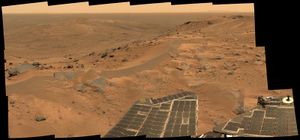Environmental conditions
The Environmental conditions on Mars are different from those of Earth. Human beings can not live there without technical systems. Unless successful terraforming can be performed, Martian settlers are bound to artificial habitats.
Contents
Temperature
The temperatures on the Martian surface is much lower than on Earth.
- Average atmosphere temperature: -63 °C
- Diurnal temperature range: -89 °C to -31 °C (Viking 1 Lander site)
- Minimum: −125 °C near the poles in winter
- Maximum: 20 °C near the equator
Atmosphere pressure
The Martian atmosphere has one hundredth of Earth's atmospheric density and seven thousandths of Earth's atmospheric pressure. The pressure varies considerably from day to day, from season to season, and from place to place on Mars. For practical purposes when designing pressure vessels to maintain life supporting conditions on Mars it is sufficient to estimate the Martian atmospheric pressure as zero.
Note that during the southern winter, a significant fraction of the planet's carbon dioxide atmosphere freezes out as dry ice. This Sublimates back to gas in the southern summer. Thus there is a slow varying of air pressure throughout the Martian year.
Wind
High wind speeds can occur in large-scale storms or small dust devils. There is evidence that wind speeds can exceed 50 meters/second (111 miles/hour). However, the thin atmosphere means that the pressure created by wind is weaker by a factor of 9 than it would be at the same wind speed on Earth. Generally high winds will probably not be a threat to human explorers, with the possible exception of areas where the ground slopes steeply.[1]
Wind speed (Viking Lander sites)
- Summer: 2-7 m/s
- Fall: 5-10 m/s
- Dust storms: 17-30 m/s
- Dust devils: Typically 10 m/s, max speed at Viking landers estimated at 46m/s.
Dust
Airborne dust presents potential problems for human explorers. Dust could wear on moving parts if it infiltrates machinery, or could wear away EVA suit seals. Dust that enters a habitat after an EVA could clog air filters. It could accumulate on solar panels, antennas, optical sensors, thermal radiators, or EVA suit visors. The electric charge generated by rover wheels could cause dust adherence that interferes with the drive train.[1] Also note that the Martian dust is composed of 'fines', very small particles. This will be especially stressful on moving parts.
Martian dust is somewhat toxic, (containing perchlorates), so efforts may be taken to minimize tracking it in to the habitat modules. If water is locally available, showers could be provided in air locks or mud rooms.
Electrostatic Charging
Human explorers may need to deal with electrostatic shock hazards. On Earth, soil contains enough moisture to conduct electricity, which means electric charge will not build up in grounded objects. Not enough liquid water is present for this effect to occur on Mars. The discharge of built-up static electricity might damage electronics. Equipment and procedures will need to be designed to account for this hazard. Some methods to overcome this sort of problem have been devised at a research station in Antarctica, where the ground contains ice but not liquid (conductive) water.[1]
Radiation
Surface radiation levels, solar storms, galactic cosmic rays.
External Links
- Nasa: Mars Fact Sheet
- Nasa: World Book
- Nasa: Atmospheric Pressure
- Beaty, DW, et al. 2005. An Analysis of the Precursor Measurements of Mars Needed to Reduce the Risk of the First Human Mission to Mars.







